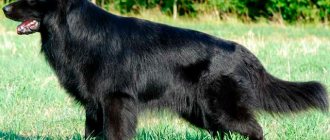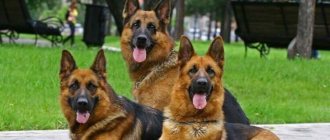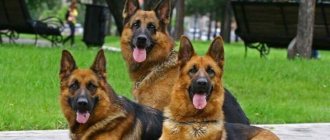History of the black German Shepherd breed
The history of the German Black Shepherd began more than a hundred years ago. The black German was bred back in the nineteenth century in Germany. In this country it is considered a national symbol and pride.
According to the generally accepted official version, all smooth-haired dogs are natural descendants of the wild Indian wolf and purebred agile dogs. These pets served as sheep shepherds (hence the name) and guards.
Dark color is a recessive trait inherent in the genes of German representatives of any color. Black offspring can also be born to black-haired parents.
Description of the breed and character of the black German Shepherd
The characteristics and parameters of a black German are practically no different from representatives of other colors. They have such qualities as:
- calm;
- equilibrium;
- patience;
- devotion and willingness to give his life for the owner. And the dog doesn’t care about the size of the enemy at all. Even if it looks many times larger, the dog will rush to defense without thinking;
- good attitude towards other animals in the house;
- alertness and vigilance.
The black German Shepherd does not show aggression, is affectionate and hardworking. She will not bark for no reason or wander aimlessly. Each of her actions is thoughtful and specific.
Varieties of shades of zonar wool
Zonar Germans are divided by color into zone-gray and zone-red. Thus, the zone-red long-haired German Shepherd has a red pigment in its coat. With the zone-gray color of the German Shepherd, the coat of a purebred dog contains only gray and black pigment.
Subspecies of zone-gray colors include:
- black and gray;
- dark gray with a characteristic “mask”;
- dark gray with a bright “belt” on the German’s back;
- gray of varying intensity;
- gray-black;
- gray-black with a characteristic “mask” on the German’s face.
Subspecies of zone-red colors in German Shepherds include:
- yellow color with an admixture of grayish;
- grayish color mixed with brown and black;
- grayish with an admixture of brown and black spots on the paws and toes.
In German Shepherds of zonal color, up to three years of age, the coat sometimes changes the degree of saturation.
Standards for the Dark German Shepherd breed
The black German smooth-haired shepherd is very easy to recognize: a uniform deep color without spots, a stately posture and a strong chest. The requirements for the reference representative exclude wavy hair and snow-white color.
What should a black German Shepherd look like?
The “standard” of a purebred representative of black color is considered to be a dog with the following characteristics:
- rectangular powerful body, pronounced muscularity;
- “mane” on the back of the head, on the chest;
- hanging tail with a deflection;
- rounded paws with darkened claws;
- wedge-shaped structure of the muzzle;
- brown eye color. The eyes themselves have an almond-shaped cut;
- protruding triangular ears and a few other features.
What types of black German shepherds are there?
Longhair
It can be purely black, fluffy, with a weak undercoat and protruding fur on the ears and tail. She looks incredibly impressive. A long-haired representative of the black color is born even from smooth-haired parents. They shed more, so they require regular brushing.
Shorthair
The black shorthaired shepherd has denser hair. The advantage of shorthaired dogs is that they shed much less frequently and less. But they also require combing.
Dimensions and weight of a German Shepherd dog
Adult females reach a height of 55 to 60 centimeters at the withers, and usually weigh 30-32 kilograms. Males are larger: their height is from 60 to 65 centimeters, and their weight is from 30 to 42 kilograms.
Breed marriage
Representatives of black color dogs with the following obvious signs do not fit the pure “standard”:
- light spots on the chest or elsewhere;
- wavy hair;
- not brown eyes;
- white color
History of the origin of the German zonal color
The zone color is recognized as the most common color among standard German Shepherds. The history of coloring began in ancient times. The distant ancestors of the Zonarniks looked impressive and stately. This pleasant zonular gray color has been passed down from generation to generation. And at the beginning of the twentieth century, it began to be found almost everywhere.
Of course, at cynological exhibitions, preference is given to black-haired representatives of the breed. However, zoners are recognized leaders in hunting, training, competitions and various work.
Modern German zoners have the following external parameters:
- slightly elongated body with a wide back, muscular deep chest;
- wedge-shaped head with a narrowing towards the nose, the size of the skull is small;
- almond-shaped eyes;
- iris color – dark brown;
- wide protruding ears, set high on the top of the head, pointed at the ends;
- the front and hind legs are straight, developed, without bends;
- saber-shaped tail, there is a slight deflection;
- long or short hair.
Maintenance and care of a black German Shepherd
Not only its upbringing and development, but also its life expectancy depends on how much time and work the owner puts into his pet.
Raising, training and intelligence of a dog
The Black German Shepherd is one of the most intelligent four-legged dogs. Of course, the owner’s participation plays a key role in its development. Without proper training, your pet's intellectual potential will not be revealed. It is necessary to engage in training starting from two to three months of age.
Many courses have been developed to teach your dog certain skills and tricks. Among the commands that can be taught to a black German Shepherd are:
- “You can’t” or “Ugh.”
- “Near” or “Toe.”
- "Sit".
- "Lie".
- "Aport" and so on.
In order for the training of a black German Shepherd to be successful, certain rules have been established:
- We must be persistent. It is necessary to ensure that the dog ultimately fulfills the command that is required of him. Encouragement is also important. It's a piece of food or verbal praise.
- There is no need to require the dog to perform new commands until it learns to clearly and accurately carry out the previous ones.
- You need to try to be understandable for your pet. Take consistent and predictable actions.
- You can't deceive or joke. In this case, the owner may lose the trust of his dog.
- There is no need to exercise until the dog is in satisfactory condition. Stress and physical and emotional overload of the four-legged animal should not be allowed.
- You need to give commands confidently. Don’t hesitate and don’t mutter under your breath. Speak loudly, clearly and strictly.
- Move from simple to complex. Until the dog masters one stage, do not move on to the next.
- Use encouragement correctly. Give your pet a treat only after the exact execution of a command or trick. A complete lack of rewards will quickly lead to a German Shepherd losing interest in training and learning.
Caring for a black German Shepherd
Proper care is the key to a long and happy life for your pet. Concerns will require:
- Wool. During the molting period, you need to comb your pet daily. If the dog lives in an enclosure, you need to bathe him once every two months (but provided that he is very dirty, otherwise he needs to be washed even less often).
- Teeth. Black German Shepherds, like most other four-legged dogs, are prone to developing tartar and plaque. To prevent this, you will need a dog brush and toothpaste. If your dog refuses to be cleaned, you should try giving him cleansing tablets. When he chews them, they clean his teeth.
- Ears. You should check your ears regularly. If a build-up of sulfur appears, it needs to be cleaned. Long-haired pets need to remove fur from their ears.
- Eyes. The four-legged dog needs to have a solution instilled into its eyes to maintain their health and moisture. Only the veterinarian can prescribe which solution should be dripped.
- Claws. To cut them you need to buy a nail clipper. For a purebred quadruped, the sickle-shaped one is better suited. You need to carefully cut off the excess length of the claws without touching the pink part. If the claws are dark, you need to look at them from below. The “live” part will be light in color. If you accidentally wound your paw and start bleeding, you should immediately treat it with hydrogen peroxide.
Feeding the dog
You can feed either prepared food or natural products. In the first case, preference should be given to the premium or super-premium class. This is due to the fact that budget food does not contain a sufficient amount of useful microelements and is often made from questionable raw materials.
Well-proven dry foods include:
- Royal Canin. At the beginning of its activity, this French brand produced food specifically for German shepherds.
- Purina ProPlan. The company also produces super-premium food and develops unique lines of medicinal food.
- "Farmina", "Acana". These are holistic, that is, ecological and the healthiest foods. They never contain chemical food additives, dyes or preservatives. However, they are even more expensive than super-premium food.
Important feeding rules have been established for natural pets:
- avoid overeating and undereating. You need to clearly measure the portion. In particular, before vigorous physical activity (overeating threatens intestinal volvulus). Veterinarians recommend feeding your dog after a walk;
- There is no need to give your pet pork and lamb. Such meat is poorly and difficult to digest, and is even a carrier of canine distemper;
- Protein should be the basis of the diet. But this does not mean that the animal should be fed exclusively meat. You can't do that. It is necessary to add fermented milk products with a low fat content (kefir, natural yogurt) to the menu;
- you need to feed twice a day at the same time, based on your pet’s daily routine;
- change drinking water daily, wash the bowl;
- prohibited foods: milk, legumes, sweet and flour products, salt (and other seasonings and spices), cereals (except rolled oats).
Walking with a German Shepherd
A black German Shepherd should be allowed to walk outside every day for at least two hours. Usually this time is divided into two walks: morning and evening. You can play with her or train and reinforce learned commands.
You don't need to give your dog anything to eat from the ground and make sure he doesn't get hurt. Avoid contact with stray stray dogs, as they are often carriers of various diseases.
If a black four-legged animal lives in an enclosure and has independent free access to the local area, this does not cancel regular and long walks with it.
Pet vaccinations
The very first vaccination takes place at two months of age. The baby is vaccinated against a whole range of diseases: enteritis, plague, adenovirosis, leptospirosis, etc. A month later, a booster vaccination is given against the same diseases.
At six to eight months of age, a black German Shepherd is vaccinated against rabies. Revaccination is required annually.
Before vaccination, it is recommended to give your dog an anthelmintic a week before. On the day of the vaccine, the veterinarian should take his temperature and carefully examine him.
Dog mating
To breed a purebred representative of the suit, it is important to prepare in advance. To select a male black German shepherd, you need to study his pedigree, look at photographs in order to maximally predetermine the physiological characteristics of the offspring (i.e., select the phenotype).
There is no need to breed individuals of obviously different sizes. This can lead to disproportionate body shapes in future children (eg large head combined with small body, etc.).
It is also important to take age into account. If you breed a too young black female with a sufficiently old male, then there is a high risk that the offspring will be “defective”.
If a black German Shepherd girl gives birth more than once, you need to pay attention to earlier offspring. This also applies to males. This will make it possible to determine which trait is inherited by children.
Shepherd and child
The black German Shepherd loves children very much. They will quickly find a common language with each other and become friends. An adult dog will never offend a child, even if he tries to piss her off. However, you still shouldn’t let your baby treat her like that. It is necessary to explain to the child that a German is a full-fledged member of the family, who also has needs and demands respect, and is not a toy that can be offended or beaten.
But it is better not to leave the puppy alone with the newborn. He may inadvertently cause him harm because he rejoices too much at each such meeting.
Key points in training
“Germans” are incredibly smart and always want to please their owner; the training process does not bring much trouble. German Shepherds enjoy exercising, especially if the training is done through positive reinforcement.
Training is necessary, otherwise the pet’s irrepressible energy will go in the wrong direction. The main obstacle to training can be the dog's hyperactivity, which interferes with concentration. Team training should begin after a walk, so that natural needs do not distract the pet from training.
Read about how to properly train a dog in the article: “Training a puppy: effective methods from dog handlers, learning commands at home.”
Advantages and disadvantages of the breed
The main advantages of a black German are:
- Fast learner. Germans are great at learning commands and learning different tricks.
- Intelligence. They are smart and quick-witted.
- Love for children and other pets.
- Unpretentious care, quick adaptation to any conditions.
- Not picky about food. The main thing is to balance the diet and feed at the same time.
- Devotion and fidelity.
- Protection of the owner from any stranger (and not only). The owner will be protected even from those who try to argue with him or raise their voice.
The disadvantages include:
- Large amount of lost hair. You will have to get used to cleaning the house every day.
- "Doggy" smell.
- Excessive energy. If you don’t give your pet enough time, he will begin to destroy everything that surrounds him.
- Damage to furniture and other things. This is true if your pet lives inside a house or apartment.
- Barking. The German's voice is quite loud and sonorous, so you'll have to get used to it.
How to choose a black German Shepherd puppy?
To make sure that the dog will be black, you need to buy it no earlier than two months of age. The eyes should be brown, not cloudy and clear. You need to carefully examine the baby and observe his behavior. She should not be scared and run away from people she does not know. Usually puppies are attracted to and interested in people from their very “infancy”.
In addition, you need to request documents from the seller: veterinary passport, information about vaccinations. It is worth noting the conditions of detention in which the baby was before the purchase. It is important that he is kept clean and well fed.
Nutrition
A German Shepherd puppy needs a complete, balanced diet. If fed incorrectly, he will grow up weak, sad and distant, and his coat will not have shine. It is important that the baby receives amino acids and proteins every day. These nutrients are found in milk, cereals and meat.
A complete list of foods that should be fed daily to a puppy from 2 to 8 months:
- Buckwheat or wheat porridge.
- Chicken (preferably raw).
- Milk or semolina.
- Cucumbers, broccoli, lettuce, tomatoes.
- Bananas, strawberries, apples, melon.
Never feed your pet raw sea fish, as it contains bones and possibly parasites. It is also recommended to permanently eliminate pork, smoked lard, sharp bones (especially beef), chocolate, biscuits and marmalade from his menu. Eating such foods can cause digestive dysfunction in dogs. Dry food can be given to an adult “German” over 1 year old.
Do you need an aviary for a German Shepherd?
As a rule, in most cases, a large dog lives on the street. And she definitely needs to build an enclosure. You can do this yourself or contact the appropriate company. If you decide to build an enclosure yourself, then you must follow the rules:
- can be used for construction metal or wood;
- take into account the size of the pet. There is no need to make his enclosure too small or large. In a small one, the dog will feel cramped and uncomfortable, but in a large one, it will be cold, especially in autumn and winter.
- Place bowls of food and water at the correct height;
- The enclosure itself needs to be cleaned once or twice a day, and don’t forget to wash the bowls. Wet cleaning should be carried out at least once a week.
Where can I buy, prices for a German Shepherd puppy
You can buy a black German Shepherd puppy:
- from professional breeders;
- in specialized nurseries;
- on online platforms. Among the popular ones are Avito and Yula.
You need to beware of fraud and carefully check all documentation, vaccination card and passport. If the seller cannot provide any supporting documents and sells the puppy second-hand, the likelihood of running into a scammer is very high.
The cost depends on the class (show, breed or pet), growing conditions, pedigree and availability of documents. The price starts from 20 thousand rubles and above. For example, a black show-class representative with a full package of documents and a good pedigree will cost at least 50 thousand rubles.
Characteristic diseases
The immunity of the German Shepherd Dog is quite strong. Representatives of the breed rarely get sick. However, not a single dog is immune from the occurrence of various diseases. Common diseases common to Germans include:
- hip dysplasia;
- skin diseases such as eczema or dermatitis;
- otitis – inflammation in the ear;
- Gastric volvulus is a very dangerous condition that, without timely surgical treatment, leads to death (in 100% of cases);
- allergies, including food allergies.
In addition, Germans are susceptible to infectious diseases. Therefore, at 2 months the puppy already receives its first vaccinations. We must not forget about post-vaccination quarantine. Your pet should not be taken outside for two weeks after vaccination.











